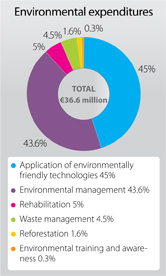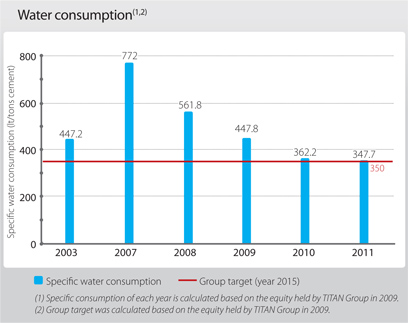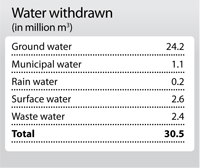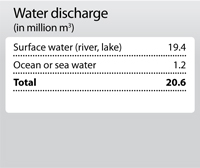

In 2011, specific water consumption was decreased by 4% compared to the previous year, slightly below the Group target of 350 lt/ton of cement. On Group level, 30.5 million m3 of water was withdrawn in total, out of which 9.9 million m3 were consumed, whereas for cement plants water withdrawal and consumption was 8.1 million m3 and 4.4 million m3, respectively. Detailed information on the quantity of water withdrawn by source as well as water discharge by destination are given in the relevant tables.

In addition, 18.9 million m3 of water or about 62% of the total withdrawn volume were recycled to cover total water needs. It is worth mentioning that cement plants operations made use of 15.5 million m3 of recycled water, which corresponds to about 190% of, or twice the water withdrawn volume.


An Integrated Group Water Management System has been developed on the corporate level and already established for use in all cement plants. Components of the system include “mapping” of the water flows, databases for water balance calculations and water quality analyses. Work is proceeding on, actively implementing an equivalent set of practices for ready-mix plants in 2012 (also a Group target). In 2011, Group-level guidance was introduced into all cement plants, leading to the development of guidelines to be incorporated in the respective environmental management systems. Continuous improvement was reflected in the reduction of all specific water consumption in 2011, compared to past performance.
TITAN is also a core member of the newly formed WBCSD/CSI Water Management Task Force. This enables the Group to follow all the latest trends in the industry, learn from other cement producers in the CSI, and lead by example through the establishment of good practices, raising the level of awareness and transparency in reporting. New KPIs were proposed by the Task Force, with priorities recognized as follows: withdrawal, consumption, discharge and recycling of water. TITAN is adopting the WBCSD/CSI definitions and KPIs, under a preparation period towards implementation of the new KPIs for water reporting, expected in the next one - two years. The Task Force Team is currently working on developing high-level guidance on good practices for water measurement, based on the experience and practices followed within the member companies of the team.
The establishment of guidance for water risk assessment is also a target in CSI, currently focusing on commercially available and established “tool kits” like the Global Water Tool. TITAN plans to run a test year in 2012, applying the “mapping” capabilities of this Tool, by utilizing all existing data from the Group system, and with a preliminary assessment for the possible sources of water risk. On the local level, other similar tools (i.e. the Local Water Tool developed by GEMI) are available and will also be used.
As part of water risk assessment and sustainable water management at specific sites, focus hydro-geological studies have been conducted in the Antea, Pennsuco and Usje plants and are under development at Zlatna Panega (Bulgaria) and SharrCem (Kosovo).
All these ongoing efforts for water risk assessment are targeting at identifying potential significant impact of water withdrawal for TITAN’s operations to water sources and finally delineating actions for an efficient water management.